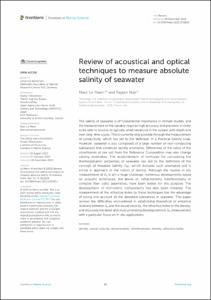| dc.contributor.author | Le Menn, Marc | |
| dc.contributor.author | Naïr, Rajesh | |
| dc.date.accessioned | 2023-06-26T19:24:24Z | |
| dc.date.available | 2023-06-26T19:24:24Z | |
| dc.date.issued | 2022 | |
| dc.identifier.citation | Le Menn, M. and Naïr, R. (2022) Review
of acoustical and optical techniques to
measure absolute salinity of seawater.
Frontiers in Marine Science, 9:1031824, 19pp.
DOI https://doi.org/10.3389/fmars.2022.1031824 | en_US |
| dc.identifier.uri | https://repository.oceanbestpractices.org/handle/11329/2300 | |
| dc.description.abstract | The salinity of seawater is of fundamental importance in climate studies, and
the measurement of the variable requires high accuracy and precision in order
to be able to resolve its typically small variations in the oceans with depth and
over long-time scales. This is currently only possible through the measurement
of conductivity, which has led to the definition of a Practical Salinity scale.
However, seawater is also composed of a large number of non-conducting
substances that constitute salinity anomalies. Differences of the ratios of the
constituents of sea salt from the Reference Composition may also change
salinity anomalies. The establishment of formulae for calculating the
thermodynamic properties of seawater has led to the definition of the
concept of Absolute Salinity (SA), which includes such anomalies and is
similar in approach to the notion of density. Although the routine in situ
measurement of SA is still a huge challenge, numerous developments based
on acoustic techniques, but above all, refractometry, interferometry or
complex fiber optic assemblies, have been tested for this purpose. The
development of monolithic components has also been initiated. The
measurement of the refractive index by these techniques has the advantage
of taking into account all the dissolved substances in seawater. This paper
reviews the difficulties encountered in establishing theoretical or empirical
relations between SA and the sound velocity, the refractive index or the density,
and discusses the latest and most promising developments in SA measurement
with a particular focus on in situ applications. | en_US |
| dc.language.iso | en | en_US |
| dc.rights | Attribution 4.0 International | * |
| dc.rights.uri | http://creativecommons.org/licenses/by/4.0/ | * |
| dc.subject.other | Sound velocity | en_US |
| dc.subject.other | Refractometer | en_US |
| dc.subject.other | Interferometer | en_US |
| dc.subject.other | Density | en_US |
| dc.subject.other | Refractive index | en_US |
| dc.title | Review of acoustical and optical techniques to measure absolute salinity of seawater. | en_US |
| dc.type | Journal Contribution | en_US |
| dc.description.refereed | Refereed | en_US |
| dc.format.pagerange | 19pp. | en_US |
| dc.identifier.doi | https://doi.org/10.3389/fmars.2022.1031824 | |
| dc.subject.parameterDiscipline | Water column temperature and salinity | en_US |
| dc.subject.instrumentType | salinity sensor | en_US |
| dc.bibliographicCitation.title | Frontiers in Marine Science | en_US |
| dc.bibliographicCitation.volume | 9 | en_US |
| dc.bibliographicCitation.issue | Article 1031824 | en_US |
| dc.description.sdg | 14.a | en_US |
| dc.description.methodologyType | Reports with methodological relevance | en_US |
| obps.contact.contactname | Marc Le Menn | |
| obps.contact.contactemail | Marc.lemenn@shom.fr | |
| obps.resourceurl.publisher | https://www.frontiersin.org/articles/10.3389/fmars.2022.1031824/full | |
 Repository of community practices in Ocean Research, Applications and Data/Information Management
Repository of community practices in Ocean Research, Applications and Data/Information Management

